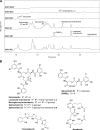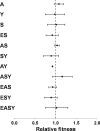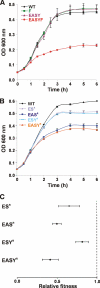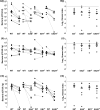Contribution of siderophore systems to growth and urinary tract colonization of asymptomatic bacteriuria Escherichia coli
- PMID: 21930757
- PMCID: PMC3255690
- DOI: 10.1128/IAI.05594-11
Contribution of siderophore systems to growth and urinary tract colonization of asymptomatic bacteriuria Escherichia coli
Abstract
The molecular mechanisms that define asymptomatic bacteriuria (ABU) Escherichia coli colonization of the human urinary tract remain to be properly elucidated. Here, we utilize ABU E. coli strain 83972 as a model to dissect the contribution of siderophores to iron acquisition, growth, fitness, and colonization of the urinary tract. We show that E. coli 83972 produces enterobactin, salmochelin, aerobactin, and yersiniabactin and examine the role of these systems using mutants defective in siderophore biosynthesis and uptake. Enterobactin and aerobactin contributed most to total siderophore activity and growth in defined iron-deficient medium. No siderophores were detected in an 83972 quadruple mutant deficient in all four siderophore biosynthesis pathways; this mutant did not grow in defined iron-deficient medium but grew in iron-limited pooled human urine due to iron uptake via the FecA ferric citrate receptor. In a mixed 1:1 growth assay with strain 83972, there was no fitness disadvantage of the 83972 quadruple biosynthetic mutant, demonstrating its capacity to act as a "cheater" and utilize siderophores produced by the wild-type strain for iron uptake. An 83972 enterobactin/salmochelin double receptor mutant was outcompeted by 83972 in human urine and the mouse urinary tract, indicating a role for catecholate receptors in urinary tract colonization.
Figures








Similar articles
-
Ferric Citrate Uptake Is a Virulence Factor in Uropathogenic Escherichia coli.mBio. 2022 Jun 28;13(3):e0103522. doi: 10.1128/mbio.01035-22. Epub 2022 May 12. mBio. 2022. PMID: 35546538 Free PMC article.
-
Roles of iron acquisition systems in virulence of extraintestinal pathogenic Escherichia coli: salmochelin and aerobactin contribute more to virulence than heme in a chicken infection model.BMC Microbiol. 2012 Jul 20;12:143. doi: 10.1186/1471-2180-12-143. BMC Microbiol. 2012. PMID: 22817680 Free PMC article.
-
Redundancy and specificity of Escherichia coli iron acquisition systems during urinary tract infection.Infect Immun. 2011 Mar;79(3):1225-35. doi: 10.1128/IAI.01222-10. Epub 2011 Jan 10. Infect Immun. 2011. PMID: 21220482 Free PMC article.
-
The Ins and Outs of siderophore mediated iron uptake by extra-intestinal pathogenic Escherichia coli.Vet Microbiol. 2011 Nov 21;153(1-2):89-98. doi: 10.1016/j.vetmic.2011.05.023. Epub 2011 Jun 6. Vet Microbiol. 2011. PMID: 21680117 Review.
-
Salmochelin, the long-overlooked catecholate siderophore of Salmonella.Biometals. 2009 Aug;22(4):691-5. doi: 10.1007/s10534-009-9217-4. Epub 2009 Feb 13. Biometals. 2009. PMID: 19214756 Review.
Cited by
-
Alterations in the colonic microbiota in response to osmotic diarrhea.PLoS One. 2013;8(2):e55817. doi: 10.1371/journal.pone.0055817. Epub 2013 Feb 8. PLoS One. 2013. PMID: 23409050 Free PMC article.
-
Back to the metal age: battle for metals at the host-pathogen interface during urinary tract infection.Metallomics. 2015 Jun;7(6):935-42. doi: 10.1039/c4mt00329b. Metallomics. 2015. PMID: 25677827 Free PMC article. Review.
-
Putative Iron Acquisition Systems in Stenotrophomonas maltophilia.Molecules. 2018 Aug 16;23(8):2048. doi: 10.3390/molecules23082048. Molecules. 2018. PMID: 30115820 Free PMC article.
-
Characterization of uropathogenic E. coli from various geographical locations in India.J Taibah Univ Med Sci. 2023 Jul 20;18(6):1527-1535. doi: 10.1016/j.jtumed.2023.07.003. eCollection 2023 Dec. J Taibah Univ Med Sci. 2023. PMID: 37693820 Free PMC article.
-
Competitive fitness of asymptomatic bacteriuria E. coli strain 83972 against uropathogens in human urine.Infect Immun. 2024 Jun 11;92(6):e0017324. doi: 10.1128/iai.00173-24. Epub 2024 May 23. Infect Immun. 2024. PMID: 38780216 Free PMC article.
References
Publication types
MeSH terms
Substances
LinkOut - more resources
Full Text Sources
Other Literature Sources
Medical

